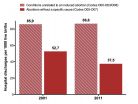(Press-News.org) Since suitable studies are lacking, it remains unclear in which sperm analysis parameters assisted reproduction using intracytoplasmic sperm injection (ICSI) can be superior to in vitro fertilization (IVF). This is the conclusion of the final report published by the Institute for Quality and Efficiency in Health Care (IQWiG) on 6 November 2014.
Benefit assessment depending on parameters
The Federal Joint Committee (G-BA) commissioned IQWiG with the examination of two research questions: First, the researchers were to assess the benefit of ICSI in comparison with IVF depending on sperm analysis parameters such as number, morphology or motility.
Secondly, IQWiG was to examine whether ICSI achieves better or worse treatment results than IVF after fertilization failure in a previous IVF attempt. Potential general advantages of ICSI in involuntary childlessness were not subject of the commission.
Supporting the decision on treatment options
On the one hand, the results were supposed to identify and characterize sperm analysis parameters for determining the indication for ICSI instead of IVF. On the other hand, they were supposed to support a decision as to which type of fertilization failure in a previous IVF attempt can be an indication for ICSI instead of another IVF.
Different techniques
In IVF, individual eggs and processed semen are combined in a test tube to allow spontaneous fertilization.
In ICSI, in contrast, a single sperm is injected directly into the cytoplasm of an egg with a micropipette. This method was developed for couples if the man's sperm quality is severely impaired and other methods of assisted reproduction have had no success.
If fertilization was achieved - both after ICSI and after IVF - the embryo is transferred to the woman's Uterus.
Prerequisite for partial payment by the statutory health insurance
In Germany, a number of prerequisites have to be fulfilled in order to use these methods of assisted reproduction and receive partial payments by the statutory health insurance.
Whereas there are six medical indications for IVF (including tubal problems), ICSI is limited to two indications: On the one hand, to male fertility problems resulting from certain characteristics from sperm analysis. On the other hand, ICSI is indicated for "total fertilization failure" after a first IVF attempt, i. e. if none of the retrieved eggs was fertilized.
Regarding the sperm analysis characteristics, the corresponding G-BA guideline refers to the WHO laboratory manual. As this manual was revised, the G-BA wants to check whether it is advisable to refer to the current manual.
Live birth is decisive for the assessment
Childbirth (live birth) is regarded to be the decisive criterion for treatment success and thus for the benefit of an assisted reproduction technique. Other patient-relevant outcomes, e.g. adverse effects such as miscarriage or pregnancy outside the cavity of the uterus (ectopic pregnancy), were also to be considered in the report.
Fertilization success is an unvalidated surrogate
The success of in vitro fertilization alone can be no more than a surrogate, which needs to be validated first. This means that in an assisted reproduction technique it has to be ensured that more (or fewer) fertilized eggs also result in more (or fewer) live births.
However, sufficient studies are lacking for this validation. Therefore IQWiG could not include a number of studies, which investigated fertilization success also in dependence on sperm analysis parameters, in the benefit assessment.
Only men with normal sperm analysis included
The researchers identified four randomized controlled trials with the outcomes "live birth", "miscarriage" and "adverse effects" on the woman's side that compared ICSI with IVF and also reported sperm analysis parameters. However, these studies exclusively included men with normal sperm analysis parameters, i.e. normal quality of sperm. Hence their results do not allow to draw conclusions on a potential association between the treatment effects of ICSI and deviations from normal sperm analysis parameters.
The second research question of the commission also remained unanswered. This was because no study could be identified that reported data on the benefit of ICSI in comparison with IVF in dependence on previous unsuccessful IVF attempts.
Process of report production
IQWiG published the preliminary results in the form of the preliminary report in May 2014 and interested parties were invited to submit comments. At the end of the commenting procedure, the preliminary report was revised and sent as a final report to the commissioning agency in September 2014. The written comments submitted were published in a separate document at the same time as the final report. The report was produced in collaboration with external experts.
INFORMATION:
Eribulin (trade name: Halaven) is approved for women with locally advanced or metastatic breast cancer in whom the disease has progressed despite prior drug therapy. The German Institute for Quality and Efficiency in Health Care (IQWiG) examined in a dossier assessment whether the drug offers an added benefit over the appropriate comparator therapy in these patient groups.
According to the findings, there are both positive and negative effects. There is proof of minor added benefit for one group of patients. For other groups, there are hints or indications of lesser ...
The current classification system for colorectal cancer, which is based on genetic expression profiles, cannot be used to predict drug responses to FOLFIRI. This is the conclusion reached by a team from the Spanish National Cancer Research Centre (CNIO), formed by members from the Gastrointestinal Cancer Clinical Research Unit and the Structural Computational Biology Group. The study, published this week in the journal Nature Medicine, will assist oncologists in making better-informed decisions regarding how to treat their colorectal cancer patients in the clinic.
Conclusions ...
Published in Nature Biotechnology, the study showed that specially engineered lipid (fat) bodies, called liposomes, can be used to prevent bacterial toxins from killing human cells.
This could prevent unnecessary deaths from diseases such as pneumonia and sepsis. The treatment is a valuable alternative to current medications, particularly for infections that have become resistant to antibiotics.
The bacterial toxins, produced by major human pathogens such as Streptococcus pneumonia, Streptococcus pyogenes and Methicillin Resistant Staphlycoccus aureus (MRSA) were ...
During hibernation, dormice enter into 'torpor' to save energy and water. In this state, the dormice become inactive and show a marked decrease in their metabolic rate, causing their body temperature to reduce.
Torpor was then found to be a strategy used when food availability was limited. The researchers compared two groups of juveniles born late in the season - one able to feed freely and the other intermittently fasted on alternate days. The fasted dormice showed considerably greater use of torpor, enabling them to maintain high growth rates and accumulate sufficient ...
Muscle-specific protein cofilin-2 controls the length of actin filaments in muscle cells.
Sliding of myosin and actin filaments past each other provides the force for muscle contraction. In contrast to most non-muscle cells, the actin filaments in muscle sarcomeres are of precise length and relatively stable. Defects in the organization of these actin filament arrays result in various heart and muscle disorders, such as myopathies.
The research group of professor Pekka Lappalainen at Institute of Biotechnology, University of Helsinki, has now revealed a new mechanism ...
Bethesda, MD -- After many generations, rats bred for their bad attitude behave differently from those selected for a calm demeanor around humans. Research published November 7 in the journal GENETICS identifies gene regions that contribute to differences between nasty and nice rats in their behavior and the activity of genes in the brain. These results may provide important clues as to which genes make tame animals like dogs behave so differently from their wild ancestors.
"Tameness is one trait that all domestic animals share. Whether it's pigs or cats or horses, domestication ...
This news release is available in Spanish.
Legal restriction of abortion has a negative connotation since the idea of women resorting to illegal abortion -risking their own lives- is strongly rooted in the public opinion worldwide. However, a series of independently peer-reviewed articles, challenge this notion in some countries. The latest data in this subject have been discussed by the Chilean epidemiologist Elard Koch, Director of Research of the MELISA Institute, in the current issue of the official journal of the Chilean Society of Obstetrics and Gynecology. ...
SALT LAKE CITY, Utah, Nov. 7, 2014 - Myriad Genetics, Inc. (Nasdaq: MYGN) today presented results from a prospective clinical utility study of its Myriad myPath Melanoma test at the 2014 American Society of Dermatopathology (ASDP) annual meeting in Chicago, Ill. Myriad myPath Melanoma is a genetic test that differentiates malignant melanoma from benign skin lesions across all major melanoma subtypes. Key findings of this clinical utility study included a 43 percent reduction in indeterminate diagnoses and a 49 percent change in physicians' treatment recommendations for ...
Scientists from the RIKEN BioResource Center in Tsukuba, Japan, have discovered that a single mutation in the beta-catenin gene, which codes a protein known to be deeply involved in a number of developmental and homeostatic processes, can lead to infertility not through a disruption of the production of egg or sperm cells, but rather by leading to abnormalities in the morphology of the sexual organs, making natural reproduction impossible.
Beta-catenin is an essential protein in the Wnt/beta-catenin signaling pathway, which has been shown in mice to be involved in the ...
It arises from what scientists previously described as "junk DNA" or "the dark matter of the genome," but this gene is definitely not junk.
The gene GAS5 acts as a brake on steroid hormone receptors, making it a key player in diseases such as hormone-sensitive prostate and breast cancer.
Unlike many genes scientists are familiar with, GAS5 does not encode a protein. It gets transcribed into RNA, like other genes, but with GAS5 the RNA is what's important, not the protein. The RNA accumulates in cells subjected to stress and soaks up steroid hormone receptors, preventing ...

